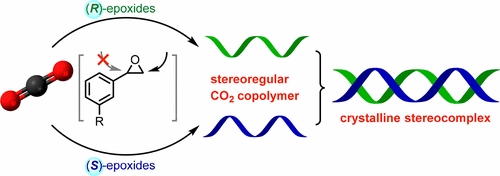当前位置:
X-MOL 学术
›
Macromolecules
›
论文详情
Our official English website, www.x-mol.net, welcomes your
feedback! (Note: you will need to create a separate account there.)
Stereoregular CO2 Copolymers from Epoxides with an Electron-Withdrawing Group: Crystallization and Unexpected Stereocomplexation
Macromolecules ( IF 5.1 ) Pub Date : 2017-09-08 00:00:00 , DOI: 10.1021/acs.macromol.7b01317 Wei-Min Ren 1 , Tian-Jun Yue 1 , Xue Zhang 1 , Ge-Ge Gu 1 , Ye Liu 1 , Xiao-Bing Lu 1
Macromolecules ( IF 5.1 ) Pub Date : 2017-09-08 00:00:00 , DOI: 10.1021/acs.macromol.7b01317 Wei-Min Ren 1 , Tian-Jun Yue 1 , Xue Zhang 1 , Ge-Ge Gu 1 , Ye Liu 1 , Xiao-Bing Lu 1
Affiliation

|
Highly regioselective copolymerization of CO2 and enantiopure terminal epoxides with an electron-withdrawing group, styrene oxide and its derivatives, was achieved by the use of multichiral salenCo(III) complex-based catalyst systems, in which epoxide ring-opening predominantly occurred at methylene C–O bond, affording isotactic CO2 copolymers with up to 98% head-to-tail connectivity and 97% enantioselectivity. The stereoregular poly(styrene carbonate) with 98% isotacticity is a typical semicrystalline material, possessing a melting temperature (Tm) of 137.3 °C and an enhanced glass transition temperature (Tg) of 101.2 °C. The isotactic 3-methoxystyrene oxide/CO2 copolymer is also a semicrystalline polymer with a Tm of around 90 °C, while the corresponding isotactic 3-chlorostyrene oxide/CO2 copolymer appears amorphous feature, possessing a Tg of 82.1 °C. Notably, a novel stereoselective interaction between two opposite-configuration isotactic polymers was first found in the blend of equivalent (R)- and (S)-polycarbonates from terminal epoxides. The strong interlocked interaction between isotactic (R)- and (S)-poly(styrene carbonate)s affords the crystalline stereocomplexes with a Tm of 164.1 °C, about 27 °C higher than that of the enantiopure isotactic polymers. Surprisingly, isotactic (R)- or (S)-3-chlorostyrene oxide/CO2 copolymer is typical amorphous polymeric material; however, upon mixing both enantiomers together, an interlocked interaction between polymer chains of opposite configuration occurs, affording the crystalline stereocomplexes with a Tm of 147.3 °C.
中文翻译:

带有吸电子基团的环氧化合物的立体球型CO 2共聚物:结晶和意外的立体复杂化
通过使用基于多手性SalenCo(III)配合物的催化剂体系,可以实现CO 2和具有吸电子基团的对映体末端环氧化物,环氧乙烷及其衍生物的高度区域选择性共聚,其中环氧化物的开环主要发生在亚甲基上C–O键,可提供等规立构的CO 2共聚物,其头对尾连接性高达98%,对映选择性为97%。具有等规度为98%的立体规则的聚碳酸苯乙烯酯是典型的半结晶材料,其熔融温度(T m)为137.3℃,玻璃化转变温度(T g)为101.2℃。等规3-甲氧基苯乙烯氧化物/ CO 2该共聚物也是T m约为90℃的半结晶聚合物,而相应的全同立构3-氯苯乙烯氧化物/ CO 2共聚物则表现出无定形特征,其T g为82.1℃。值得注意的是,两种相反构型的全同立构聚合物之间的新型立体选择性相互作用首先是在端部环氧化物的等效(R)-和(S)-聚碳酸酯的共混物中发现的。等规(R)-和(S)-聚(碳酸苯乙烯)之间的强互锁相互作用提供了T m的结晶立体配合物熔点为164.1℃,比对映纯等规聚合物高约27℃。令人惊讶地,全同立构的(R)-或(S)-3-氯代苯乙烯氧化物/ CO 2共聚物是典型的无定形聚合物材料。然而,将两种对映异构体混合在一起时,相反构型的聚合物链之间会发生互锁的相互作用,从而提供具有147.3°C的T m的晶体立体配合物。
更新日期:2017-09-08
中文翻译:

带有吸电子基团的环氧化合物的立体球型CO 2共聚物:结晶和意外的立体复杂化
通过使用基于多手性SalenCo(III)配合物的催化剂体系,可以实现CO 2和具有吸电子基团的对映体末端环氧化物,环氧乙烷及其衍生物的高度区域选择性共聚,其中环氧化物的开环主要发生在亚甲基上C–O键,可提供等规立构的CO 2共聚物,其头对尾连接性高达98%,对映选择性为97%。具有等规度为98%的立体规则的聚碳酸苯乙烯酯是典型的半结晶材料,其熔融温度(T m)为137.3℃,玻璃化转变温度(T g)为101.2℃。等规3-甲氧基苯乙烯氧化物/ CO 2该共聚物也是T m约为90℃的半结晶聚合物,而相应的全同立构3-氯苯乙烯氧化物/ CO 2共聚物则表现出无定形特征,其T g为82.1℃。值得注意的是,两种相反构型的全同立构聚合物之间的新型立体选择性相互作用首先是在端部环氧化物的等效(R)-和(S)-聚碳酸酯的共混物中发现的。等规(R)-和(S)-聚(碳酸苯乙烯)之间的强互锁相互作用提供了T m的结晶立体配合物熔点为164.1℃,比对映纯等规聚合物高约27℃。令人惊讶地,全同立构的(R)-或(S)-3-氯代苯乙烯氧化物/ CO 2共聚物是典型的无定形聚合物材料。然而,将两种对映异构体混合在一起时,相反构型的聚合物链之间会发生互锁的相互作用,从而提供具有147.3°C的T m的晶体立体配合物。









































 京公网安备 11010802027423号
京公网安备 11010802027423号